Philenoptera violacea
Philenoptera violacea (Klotzsch) Schrire
Family: Fabaceae
Common names: apple-leaf (Eng.); appelblaar (Afr.); umBhandu, umPhanda, isiHomohomo (isiZulu)
SA Tree No: 238
Introduction
The wood of this attractive, hard, frost-sensitive "rain-tree" makes a stunning ornamental display.
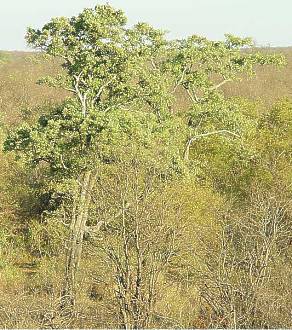
Description
Description
Philenoptera violacea is a medium- to large-sized, deciduous to semi-deciduous tree up to 15 m tall with a wide-spreading, dense and rounded crown. The main stem is tall, straight and bare, occasionally bent and twisted. The bark is grey and flaking on older branches and stem, but smooth, light grey and covered with dense hairs on younger branches, exuding a sticky red sap when cut.
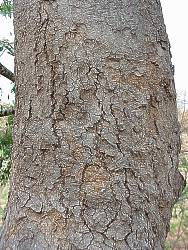
Leaves are large (70-200 mm long), unevenly compound with 1-3 pairs of opposite leaflets and one terminal leaflet, hard and rough in texture, shiny or glossy above and grey-green beneath, with prominent midribs. The terminal leaflets are always much bigger than the lower leaflets (about 180 mm long and 90 mm broad). Flowers are scattered, usually borne in dense terminal sprays 120-300 mm long at the tips of the branches, varying in colour from white and pink to bluish-pink, mauve or deep violet, and are sweet-scented. They appear from September to December, before or together with the new leaves. Fruit is a flat pod, non-splitting, relatively large (about 120 x 25 mm), hairless, tapering at both ends, persisting on the tree during winter, usually 2- or 3-seeded.
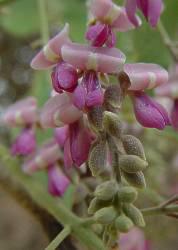
The seeds are kidney-shaped, reddish, and compressed.
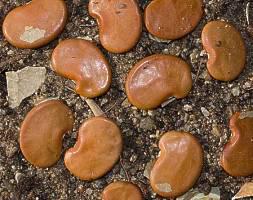
Conservation Status
Status
Philenoptera violacea is a protected tree in South Africa.
Distribution and habitat
Distribution description
Philenoptera is a small genus of 12 species, found in Madagascar, and tropical and southern Africa. Seven of these species occur in southern tropical Africa and southern Africa. South Africa is home to three species of Philenoptera, which are found in four provinces of the country, namely Limpopo, Mpumalanga, KwaZulu-Natal and Eastern Cape.
Philenoptera violacea is distributed in three provinces of South Africa: Limpopo, Mpumalanga and KwaZulu-Natal. In Limpopo it is found in the northern part of the province. In Mpumalanga it occurs in the warmer, almost frost-free parts of the Lowveld and the northern bushveld regions, and in KwaZulu-Natal it is distributed in the northern part of the province.
Derivation of name and historical aspects
History
The name Philenoptera is derived from the Greek words philenos (tractable or manageable) and pteros (wing) which conveys the meaning that the wing makes the pod manageable for dispersal. Violacea is derived from the Latin word violaceus (violet) which refers to the violet (blue-red) flowers of the apple-leaf tree.
Ecology
Ecology
Philenoptera violacea is a frost-sensitive and drought-resistant species. The tree is frequently attacked by the spittle bug or frog-hopper, which causes exudation of water from stem and branches to such an extent that the ground or area covered by this plant is wet, allowing it to use the moisture in drought conditions. It occurs at low altitudes, from 50-1250 m, in drier areas, mostly on sandy or alluvial soils. Plants are usually found in bushveld, open wooded grassland, on the banks of seasonal streams, near water courses and on floodplains.
Uses
Use
Philenoptera violacea has economic value as the wood is used to make good, attractive household articles such as grinding blocks and tool handles. Generally the wood is commercialised in making carvings, grain mortars, building poles and mealie stampers. In African tradition, it is also used to make dug-out canoes. The leaves of the apple-leaf tree provide forage for giraffes, and the pods serve as a source of nourishment to these animals.
In southern Africa, P. violacea is used in traditional remedies. Most parts of the plant are used to treat diarrhoea. The roots are used for gastro-intestinal problems; powdered root-bark is used to treat colds and snakebite. Root infusions are commonly used as part of a hookworm remedy.
Growing Philenoptera violacea
Grow
The apple-leaf tree is a good garden subject owing to its graceful habit, pale foliage and beautiful flowers. Although it grows slowly, it is an interesting ornate tree which gives a stunning display when in flower.
Propagation is by seed. The seeds must first be soaked in hot water, left overnight and planted the next morning in seedling trays. Cover the seeds lightly with river sand and keep moist. Placing a clear glass over the seedling tray can speed up germination.
Seeds usually germinate in four to six days after being sown. The plants should be kept in partial shade for three to five weeks before moving them into full sun, and should be planted in scattered clumps in a suitable habitat. The success rate of P. violacea is greater in frost-free areas. The plant is not frost-resistant, but it can survive in colder climates if properly protected during the first two to four years.
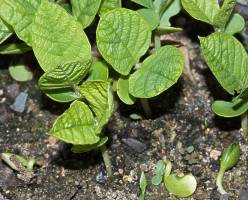
References
- Glen, H. 2004. What's in a name? The meaning of the botanical names of trees. Jacana, Johannesburg.
- Hutchings, A., Scott, A.H., Lewis, G. & Cunningham, A.B. 1996. Zulu Medicinal Plants. An Inventory. University of Natal Press Publishers, Pietermaritzburg.
- Leistner, O.A. 2005. Seed plants of southern tropical Africa: families and genera. Southern African Botanical Diversity Network Report No. 26. SABONET, Pretoria.
- Pooley, E. 2003. The complete field guide to trees of Natal, Zululand & Transkei, edn 4. Natal Flora Publications Trust, Durban.
- Schrire, B.D. 2000. A synopsis of the genus Philenoptera (Leguminosae-Millettieae) from Africa and Madagascar. Kew Bulletin 55: 81-93.
- Van Wyk, A.E. (Braam) & Van Wyk, P. 1997. Field guide to trees of southern Africa. Struik, Cape Town.
- Van Wyk, P. 1972. Trees of the Kruger National Park. Purnell & Sons, Cape Town.
- Venter, F. & Venter, J. 1996. Making the most of indigenous trees. Briza Publications, Pretoria.
- Von Breitenbach, F. 1965. The indigenous trees of Southern Africa, vol. 3. Government Printer, Pretoria.
Credits
Sifiso Mnxati
KwaZulu-Natal Herbarium
December 2009
Plant Attributes:
Plant Type: Tree
SA Distribution: KwaZulu-Natal, Limpopo, Mpumalanga
Soil type: Sandy
Flowering season: Spring, Early Summer
PH: Neutral
Flower colour: Blue, White, Pink, Mauve/Lilac
Aspect: Full Sun, Morning Sun (Semi Shade), Afternoon Sun (Semi Shade)
Gardening skill: Average
Special Features:
Horticultural zones








Rate this article
Article well written and informative
Rate this plant
Is this an interesting plant?
Login to add your Comment
Back to topNot registered yet? Click here to register.